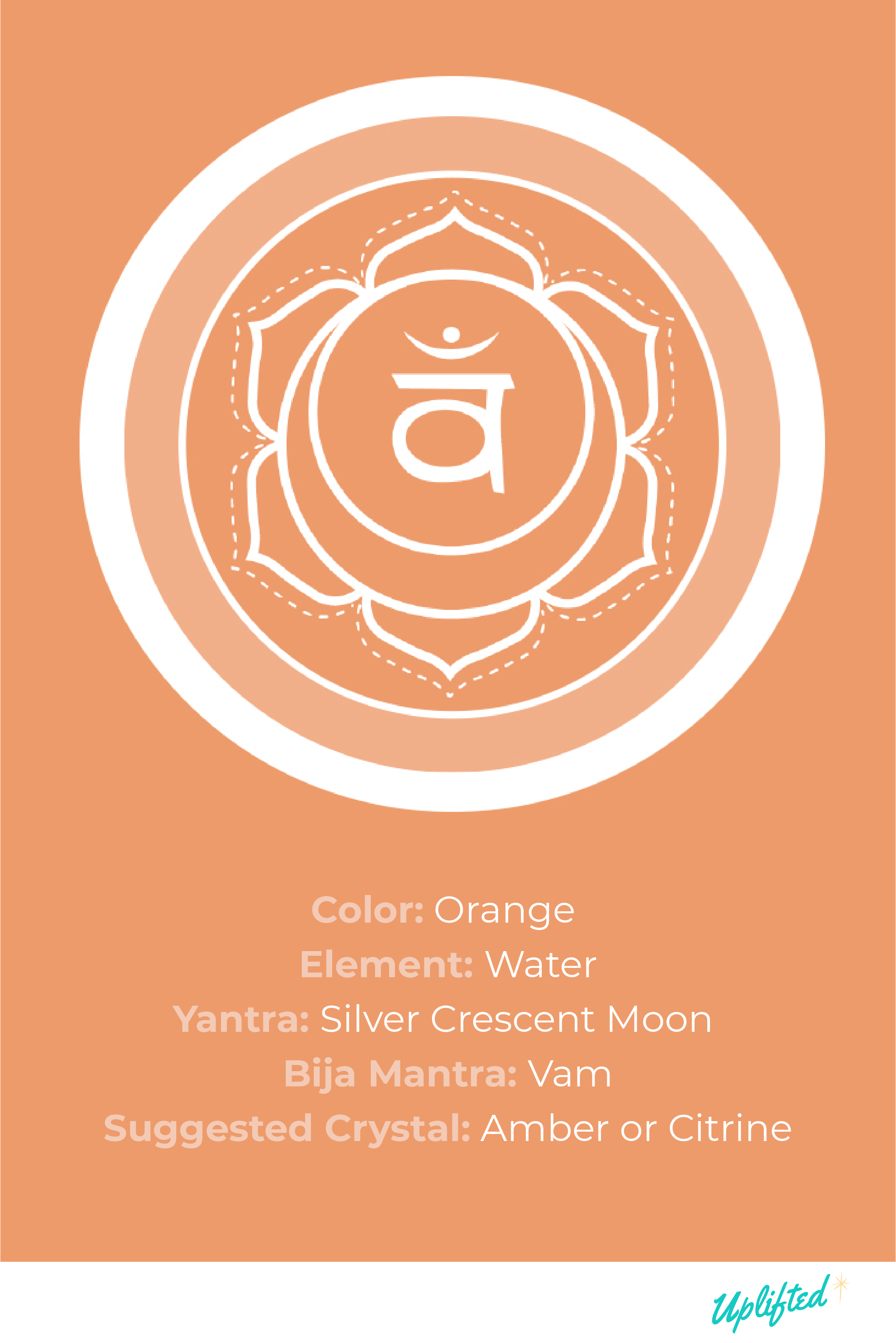Now that you’ve gotten basic old-fashioned schoolin’ in the art of chakra myth-busting, it’s time to move on up the chakra ladder.
Why?
Because the next chakra in the commonly-recognized Seven Chakra system is generally considered to be located somewhere just above the first chakra, or base chakra: Manipura. While the energy associated with each chakra can certainly move throughout the body, feelings associated with the second chakra are frequently experienced in the sacrum.
What is the Sacral Chakra?
The sacral chakra is also called svadisthana, the Sanskrit word for “dwelling place of the Self.” The second chakra of the main chakras governs our relationship with change.
It also is where our deepest desires are located, where we hold our creative potential to enact change and beauty in the world. When we hear of sacral chakra energy, it’s usually connected with sensuality, creativity, and the ways we cultivate joy and abundance in our lives.
Why is the Second Chakra Important?
The chakra meaning for svadisthana gives us a lens through which we can measure and improve our mental, emotional, and physical flexibility.
A balanced second chakra allows us to embrace change fearlessly instead of clinging to our notions of what the past or future should look like.
When we learn to accept this naturally fluid state of life, we can relax into the present moment and appreciate those around us, yielding more satisfaction in our romantic and sexual relationships, and greater overall health and well-being.
When we eliminate chakra blockages in our energy center for creativity, we are also able to connect with our individual, unique gifts.
Through chakra balancing practices, we learn to identify how best to use these gifts on our life path. Thus, when we work through the emotions attached to the second chakra, we often gain clarity and discover a way forward, a blueprint for existing in peace and contentment.
What does a Sacral Chakra Blockage Feel Like?
Here’s the bad news: it’s super common for folks who spend their days sitting or driving to experience imbalance in the sacral chakra.
When the muscles and tendons surrounding our reproductive organs get tight, it is harder for us to remain open to change and adversity.
(If you’ve ever sat in Los Angeles traffic, you’ll know exactly what I’m talking about.)
A blocked sacral chakra can manifest itself as overwhelming negative emotions, discomfort with masculine and feminine sexuality, inability to connect with others, or lower-back pain.
On the other hand, excessive “orange chakra” energy flow can be expressed through unfulfilling, unbridled sexuality, lack of stability and emotional well-being, and unstructured creative energy flow.
The good news: you can overcome a blocked sacral chakra or sacral chakra imbalance through a range of methods to balance your chakras.
Let’s heal!

Take my chakra quiz to find your dominant chakra:
Methods of Sacral Chakra Healing
Chakra Yoga
There are several yoga asanas, or postures, that can help with chakra balancing in your “dwelling place.”
As a general guideline for svadisthana chakra yoga, you want to find fluidity and cultivate stillness. Practice longer holds of hip-opening yoga postures, and flow your spine through gentle movement to massage your kidneys, found against the back muscles beneath your ribcage.
As you experiment with longer holding times in hip openers, pay attention to your state of mind; mood swings and emotional turbulence are not uncommon when accessing deep tissues in the hips.
Conclude your energy healing yoga practice by resting in child’s pose comfortably.
Yoga Pose 1. Cat-Cow Pose (Marjaiasana)
From a tabletop position on all fours, draw your belly button to your spine and your shoulders away from your ears. On an inhale, slowly open your chest forward and point your tailbone to the sky, keeping your neck long and uncrunched. As you exhale, press the floor away from you as you tuck your pelvis and gaze between your thighs.

Continue this simple flow, matching your breath to your movement and massaging your kidneys and major chakras along the spine.
Yoga Pose 2. Lizard Pose
After a few rounds of Cat–Cow flow, step your right foot forward to the outside of your right hand, keeping your left knee on the ground. If you have knee pain, you can create padding for your left knee with a folded blanket.

As you inhale, lengthen your spine. As you exhale, release your pubic bone toward the floor, aiming to open the front of your left hip flexor. You can keep your hands on the floor, lower to your elbows, or bring your elbows to a cushion, because you want to try and remain in the posture for 3-5 minutes per side.
As you open the pelvic area and experience the release of sensual issues, emotionally-charged memories, and surges of creativity, meditate on embracing whatever comes up. Learning to enjoy sensual challenges is key to sacral chakra balancing.
Yoga Pose 3. Goddess Pose (Utkata Konasana)
To really embody the physical power of sensuality and creative qualities, open and balance your sacral chakra energy center in this strong standing pose.
Opening the legs wide, imagine that your back is resting against a straight wall and slide your pubic bone downward. Keep your knees tracking outward in line with your ankles and draw your navel to your spine, opening the chest wide.

Cultivate power in your yoga practice as you hold the pose, strengthening your legs and core and gently activating your sacral energy center by engaging your pelvic floor and lower abdomen.
Hold for 5-10 deep breaths to enjoy sacral chakra balancing.
Chakra Meditation
If you seek balance in your fluid, creative, and sexual energies, try chakra meditation on the second chakra.
The color often experienced in meditation upon the sacral area of the abdomen, pelvis, and genital region is the color orange.
Think of the warmth in that intermediary step between red and yellow, between root and solar plexus. As rich, iron-filled red fades to the pure illumination of yellow light, it passes through a vibrant stage of orange energy.
Thus, the sacral chakra color orange and the svadhisthana chakra represent a critical shifting point where dormant energy learns to express itself in the world. Where the support system making up your root chakra, or manipura chakra, realizes its potential in your life and comes into fruition.
To try this meditation yourself, find a comfortable seat and spend a few moments focusing your awareness on sensations in your physical body and your breath. Once you feel your attention shifting inward, bring that focus to the organs in your lower abdomen within your pelvic region.
Notice any changes in your physical symptoms. Can you feel your pelvic organs pulsating or humming with life force energy (prana)?
Continue to breathe, simply observing. As you inhale, feel the body surrounding your genital region, abdomen, and kidneys gently change shape with the expansion of your inhale, and smoothly return to their normal shape as you breathe out.
If you would like to take this meditation further, continue this fluid, subtle movement, and visualize a small ball of faint orange light beginning to alight in the very core of your spine behind your belly button.
Each time you inhale, feel the ball of light grow a tiny bit bigger and brighter. As orange light starts to fill your body, tap into the sensation of warmth, aliveness, and creative potential. Allow that orange energy to fill your entire being, and rest in a bath of chakra color orange for as long as you like.
Chanting
As you might recall, each chakra is understood to be linked with one of the natural elements. Svadisthana chakra is linked to the element of water.
You might also recall that each element can undergo healing and balance through a specific seed mantra, or bija.
When chanted during a Kundalini yoga session, or simply brought to mind during a challenging moment, this seed mantra can draw vibrations to the second chakra’s home in your spine, sending prana (or life force energy) through any blockages or imbalances.
The seed mantra associated with water, and thus with Svadisthana chakra, is Vam. When you chant it, it rhymes with “thumb.”
Related: Try Practicing the Buddhi Mudra to Balance the Water Element Within Your Body
If using the breath to perform chanting or pranayama exercises doesn’t seem to work for you, or if you prefer a silent practice, no worries.
Traditionally, the healing power of seed mantras does not rest in comprehension. In other words, the mind doesn’t have to understand the literal Sanskrit translation of Vam to reap benefits.
But if you heal by chanting in your native language, there are feelings and emotional states of being that you can invoke to find fluidity in svadisthana chakra.
Try:
I embrace change with grace and let go of the past.
I rest peacefully in the present moment.
I experience desire, and know that my desire is separate from my Self.
My creative energy flows through all my relationships with Nature, self, and others.
Or, most simply,
(Breathing in) I am here. (Breathing out) I am now.
Next Steps:
- Explore my Chakras knowledge hub to learn more about the Chakras from the blog.
- Check out my YouTube channel and find some yoga classes that you can try out for yourself!
- Join Uplifted for exclusive chakra content that you can access right from the app. Take a deep dive into your practice with me this year!
YOU MIGHT ALSO LIKE
- Chakra Dance: An Intuitive Way To Move Energy
- Crystals For Chakras: Unlock Your Energy and Balance
- Third Eye Chakra Blocked Symptoms & Healing Techniques
- Third Eye Chakra Opening Symptoms And How To Open Your Sixth Chakra
- Opening Crown Chakra Symptoms And How To Balance Sahasrara Chakra
- Opening Root Chakra Symptoms And How To Balance Muladhara
- Symptoms Of Heart Chakra Opening And How To Balance Anahata Chakra
- Sacral Chakra Awakening Symptoms And How To Balance Svadhisthana Chakra
- Blocked Throat Chakra Symptoms & Healing Techniques
- Physical Symptoms Of Solar Plexus Chakra Opening
- Opening Throat Chakra Symptoms And How To Balance Vishuddha Chakra
- Heart Chakra Blocked Symptoms & Healing Techniques
- Chakra Opening Symptoms: Signs You’re Unblocking Your Chakras
- Dominant Chakra Test: Which Chakras Are Out Of Balance?
- Blocked Sacral Chakra Symptoms & Healing Techniques
- Root Chakra Blockage Symptoms & How To Unblock It
- 7 Chakra Imbalance Symptoms: Energetic, Physical, And Emotional
- Solar Plexus Blocked Symptoms And How To Balance
- Samana Vayu: The Energy of Balance & How to Access It
- 15 Crown Chakra Affirmations to Embody Your Highest Self
- 15 Third Eye Chakra Affirmations to Deepen Spiritual Insight
- 15 Throat Chakra Affirmations for Confident Communication
- 15 Heart Chakra Affirmations to Unlock Unconditional Love
- 15 Sacral Chakra Affirmations for Joy & Emotional Healing
- 15 Solar Plexus Chakra Affirmations to Activate Personal Power
- 15 Root Chakra Affirmations for Essential Wellbeing
- What is the 8th Chakra and How Can We Tap Into It?
- What Are Nadis? Your Guide to Energy Channels In Your Body.
- Everything You Need To Know About Using Healing Stones
- Chakra Yoga: The Best Yoga Poses To Balance Your 7 Chakras
- What Are The Chakras And Kundalini Energy Flow? Here Is My Complete Breakdown.
- 35 Powerful Chakra Affirmations For Major Healing & Balancing
- Bija Mantras: The Chakra Mantras and Their Sounds
- The 7 Chakra Symbols Explained: Their Meaning & Shapes [+PICTURES]
- Sahasrara: Crown Chakra Meditation For Healing and Balancing [VIDEO]











